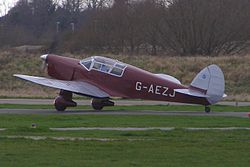Percival Vega Gull
| Percival Vega Gull | |
|---|---|

|
|
| Type: | Touring plane |
| Design country: | |
| Manufacturer: | Percival Aircraft Co. |
| First flight: | November 1935 |
| Production time: |
1935 to 1939 |
| Number of pieces: | 90 |
The Vega Gull of the British aircraft manufacturer Percival Aircraft Co. is a single-engine, civil aircraft from the 1930s. The Vega Gull is a four-seater further development of the Percival Gull series, which only had two seats, and was built in different versions from 1935. From 1939 it was also produced in special versions for the Royal Air Force , where it was used as a liaison aircraft and training machine.
Record flights
The Vega Gull machines also have a good reputation for their use in record flights.
Transatlantic non-stop flight
The pilot Beryl Markham flew on the first solo non-stop Atlantic crossing from east to west from England ( Lindbergh flew from west to east in 1927) on September 4, 1936, a borrowed Vega Gull with a 200 HP engine and navigational instruments (but no radio equipment) and additional tanks. Markham took off from London at 8 p.m. on September 4, 1936, and called on the phone from the fishing village of Baleine , Nova Scotia . Her engine failed over Nova Scotia due to icing problems in the gasoline line. During the emergency landing in a peat cut, the machine stuck its nose into the ground.
Course records
New Zealand pilot Jean Batten set other records with the Vega Gull . B. 1936 on the England - New Zealand route. Your Vega Gull is on display at Auckland International Airport .
Technical specifications
| Parameter | Data Vega Gull Mk. 4 |
|---|---|
| crew | 1 |
| Passengers | 3 |
| length | 7.77 m (25 ft 6 in) |
| span | 12.04 m (39 ft 6 in) |
| height | 2.14 m (7.021 ft) |
| Wing area | |
| Wing extension | |
| payload | |
| Empty mass | |
| max | 1474 kg (3250 lbs) |
| Cruising speed | |
| Top speed | 241 km / h (130 kts) |
| Service ceiling | 5182 m (17,000 ft) |
| Range | 1062 km (574 nm) |
| Engines |
